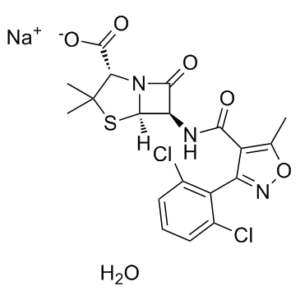Physicochemical Properties
| Molecular Formula | C19H17N3O5SCL2.NA+ |
| Molecular Weight | 493.31618 |
| Exact Mass | 509.019 |
| Elemental Analysis | C, 44.72; H, 3.56; Cl, 13.89; N, 8.23; Na, 4.50; O, 18.81; S, 6.28 |
| CAS # | 13412-64-1 |
| Related CAS # | Dicloxacillin sodium;343-55-5;Dicloxacillin;3116-76-5 |
| PubChem CID | 23675786 |
| Appearance | Solid powder |
| Boiling Point | 692.4ºC at 760mmHg |
| Melting Point | 222-225°C |
| Flash Point | 372.5ºC |
| LogP | 2.131 |
| Hydrogen Bond Donor Count | 2 |
| Hydrogen Bond Acceptor Count | 8 |
| Rotatable Bond Count | 4 |
| Heavy Atom Count | 32 |
| Complexity | 752 |
| Defined Atom Stereocenter Count | 3 |
| SMILES | [O-]C([C@@H](C(C)(C)S[C@]1([H])[C@@H]2NC(C3=C(C)ON=C3C4=C(Cl)C=CC=C4Cl)=O)N1C2=O)=O.[Na+].O |
| InChi Key | SIGZQNJITOWQEF-VICXVTCVSA-M |
| InChi Code | InChI=1S/C19H17Cl2N3O5S.Na.H2O/c1-7-10(12(23-29-7)11-8(20)5-4-6-9(11)21)15(25)22-13-16(26)24-14(18(27)28)19(2,3)30-17(13)24;;/h4-6,13-14,17H,1-3H3,(H,22,25)(H,27,28);;1H2/q;+1;/p-1/t13-,14+,17-;;/m1../s1 |
| Chemical Name | sodium (2S,5R,6R)-6-(3-(2,6-dichlorophenyl)-5-methylisoxazole-4-carboxamido)-3,3-dimethyl-7-oxo-4-thia-1-azabicyclo[3.2.0]heptane-2-carboxylate hydrate |
| Synonyms | Dicloxacillin sodium hydrate; BLP-1011; BRL-1702; P 1011; P-1011; P1011; MDI-PC |
| HS Tariff Code | 2934.99.03.00 |
| Storage |
Powder-20°C 3 years 4°C 2 years In solvent -80°C 6 months -20°C 1 month Note: Please store this product in a sealed and protected environment, avoid exposure to moisture. |
| Shipping Condition | Room temperature (This product is stable at ambient temperature for a few days during ordinary shipping and time spent in Customs) |
Biological Activity
| Targets | β-lactam |
| ln Vitro | At ATCC 25923 and E19977, dicloxacillin displays EC50 values of 0.06 and 0.50 mg/L, respectively. In ATCC 25923 and E19977, dicloxacillin displays minimum inhibitory concentrations (MIC) of 0.125 and 0.5 mg/L at pH 7.4 respectively[3]. |
| ln Vivo | When used in a murine peritonitis-sepsis model, dicloxacillin shows therapeutic activity, and all of the mice survive1–4. |
| Cell Assay |
Cell Line: Strains ATCC 25923 and E19977. Concentration: 0-500 mg/L. Incubation Time: Up to 24 h. Result: EC50 values in ATCC 25923 and E19977 were found to be 0.06 and 0.50 mg/L, respectively. |
| Animal Protocol |
Animal Model: Female outbred Swiss Webster mice (Murine peritonitis-sepsis model)[4]. Dosage: 125 mg/kg. Administration: IV injection, single doses. Result: All the mice survived. |
| References |
[1]. Enhanced renal excretion of dicloxacillin in patients with cystic fibrosis. Pediatrics. 1975 Dec;56(6):1038-44. [2]. In vitro activity effects of combinations of cephalothin, dicloxacillin, imipenem, vancomycin and amikacin against methicillin-resistant Staphylococcus spp. strains. Ann Clin Microbiol Antimicrob. 2006 Oct 12;5:25. [3]. Intra- and extracellular activities of dicloxacillin against Staphylococcus aureus in vivo and in vitro. Antimicrob Agents Chemother. 2010 Jun;54(6):2391-400. [4]. Discovery of MRSA active antibiotics using primary sequence from the human microbiome. Nat Chem Biol. 2016 Dec;12(12):1004-1006. |
| Additional Infomation |
Dicloxacillin sodium monohydrate is a hydrate. It contains a dicloxacillin sodium. Dicloxacillin Sodium is the sodium salt form of dicloxacillin, a broad-spectrum, semi-synthetic beta-lactam with bactericidal and beta-lactamase resistant activity. Dicloxacillin sodium binds to penicillin binding proteins (PBP) located on the inner membrane of the bacterial cell wall. It also inhibits the cross-linkage of peptidoglycan, a critical component of bacterial cell walls. This leads to the inhibition of bacterial cell wall synthesis and eventually causes cell lysis. One of the PENICILLINS which is resistant to PENICILLINASE. |
Solubility Data
| Solubility (In Vitro) |
DMSO : ~100 mg/mL ( ~195.95 mM ) Water : 25~100 mg/mL(~48.99 mM) |
| Solubility (In Vivo) |
Solubility in Formulation 1: 25 mg/mL (48.99 mM) in PBS (add these co-solvents sequentially from left to right, and one by one), clear solution; with sonication. (Please use freshly prepared in vivo formulations for optimal results.) |
| Preparing Stock Solutions | 1 mg | 5 mg | 10 mg | |
| 1 mM | 2.0271 mL | 10.1354 mL | 20.2708 mL | |
| 5 mM | 0.4054 mL | 2.0271 mL | 4.0542 mL | |
| 10 mM | 0.2027 mL | 1.0135 mL | 2.0271 mL |
